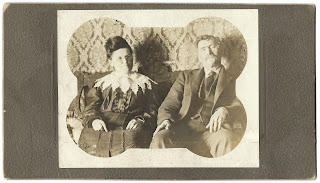 |
| Charles Joice (Personal Family Collection) |
In The Débutante’s Secret, a stranger watching Aunt Henny has a cabinet card he is often looking at. But what is a cabinet card? The term and general meaning of cabinet card has been in my little brain filed under “things I can use in my stories set in the late 1800s and on,” but I can’t remember specifically when I learned this information.
Photographs were first printed on paper from a negative in 1847. That’s a lot farther back than I realized.
 |
| Allen Calkin (Personal Family Collection) |
 |
| Agnes McGregor (Personal Family Collection) |
Cabinet cards were first introduced in 1863 in landscape format before they introduced portrait style. Though they were around in the 1870s, they rose to the height of their popularity in the 1880s and began to decline in the 1890s.
 |
| Harold Blakey (Personal Family Collection) |
Vanity, too, was a consideration. From nearly the beginning, photographers employed artists to touch up negatives to hide facial imperfections before making prints. I suppose this was wise to keep customers happy if they were going to lay down a chunk of money. Besides, the photographer’s name was generally printed or embossed on the card so others could find them to have their portrait taken.
 |
| E. D. & Mary E. Shugart (Personal Family Collection) |
With the invention of the Brownie camera in 1900 and personal photography becoming popular, cabinet cards fell out of favor. The last ones were likely made in the 1930s, but they had been mostly gone since around 1920.
***All images of cabinet cards in this post are from my private family collection and may not be used elsewhere without written permission. I feel blessed to have these treasures.
 |
| Russel & Floyd Calkin 1903 (Personal Family Collection) |
Do you prefer digital or physical copies of pictures?
August 5th I'll reveal the cover for The Lady's Mission, Quilting Circle 5.
THE QUILTING CIRCLE
Historical Romance Series
By Mary Davis
THE WIDOW’S PLIGHT (Book1) – Will a secret clouding a single mother’s past cost Lily the man she loves?
THE DAUGHTER’S PREDICAMENT (Book2) *2020 Selah Awards Finalist & WRMA Finalist* – As Isabelle’s romance prospects are turning in her favor, a family scandal derails her dreams.
THE DAMSEL’S INTENT (Book3) *2021 Selah Awards Winner& WRMA Finalist*– Nicole heads down the mountain to fetch herself a husband. Can she learn to be enough of a lady to snag the handsome rancher?
THE DÉBUTANTE’S SECRET (Book4) –Complications arise when a fancy French lady, Geneviève, steps off the train and into Deputy Montana’s arms.
THE LADY’S MISSION (Book5) – Will Cordelia abandon her calling for love? (Releases October 5, 2022)
Sources:
https://en.wikipedia.org/wiki/Cabinet_card
https://www.thoughtco.com/identifying-and-dating-cabinet-card-1422271
https://www.collectorsweekly.com/photographs/cabinet-cards
https://blog.scienceandmediamuseum.org.uk/find-out-when-a-photo-was-taken-identify-a-cabinet-card/
https://www.archivalmethods.com/blog/cabinet-cards-carte-de-visite/





No comments:
Post a Comment